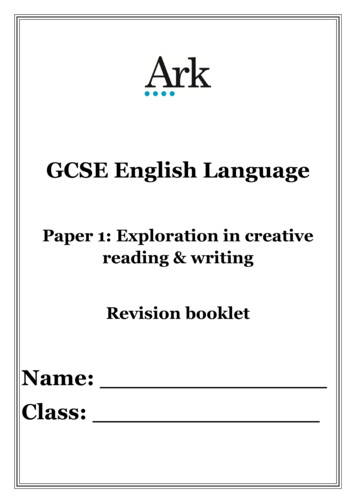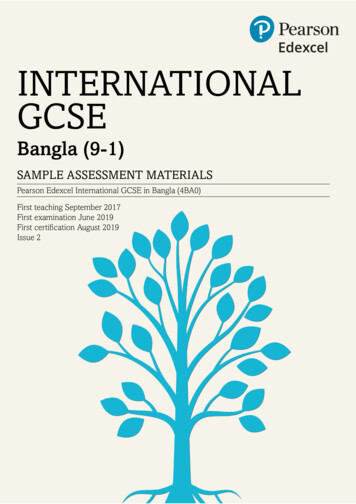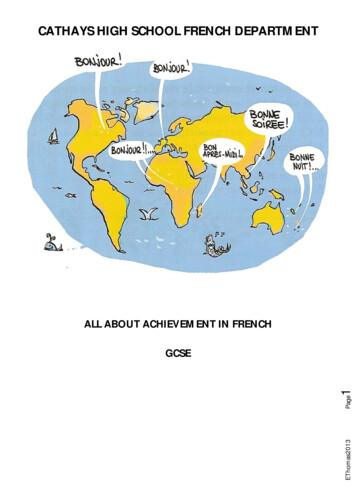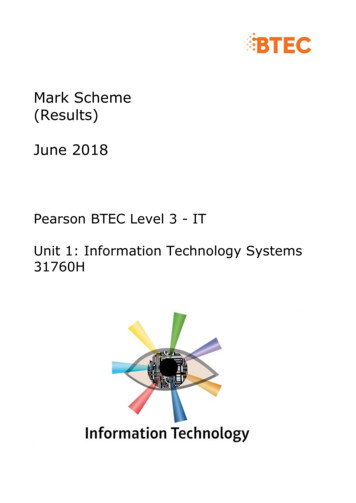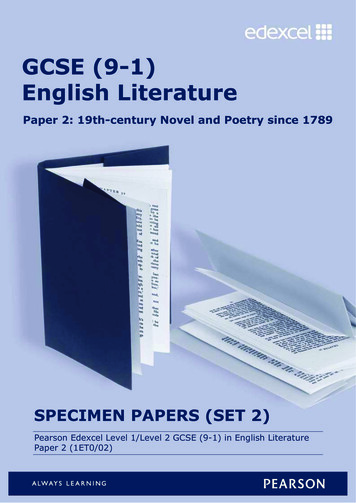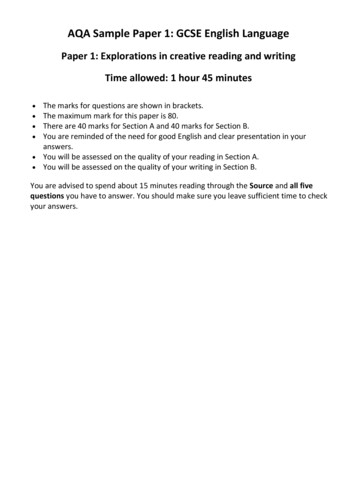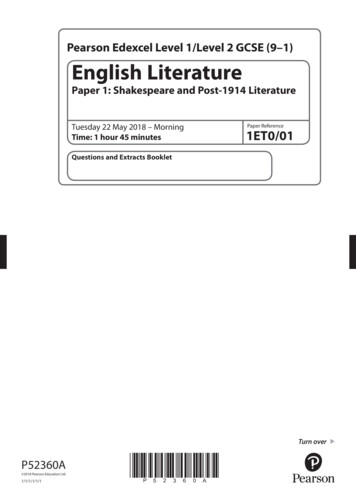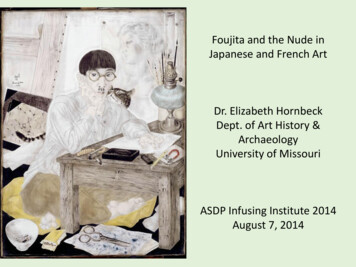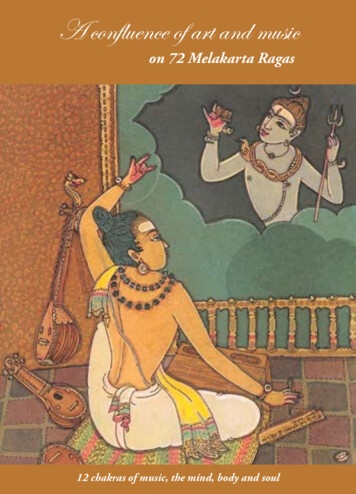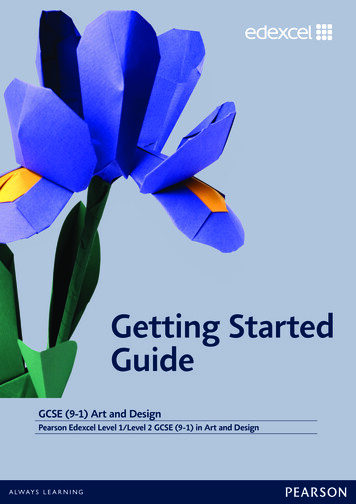
Transcription
Getting StartedGuideGCSE (9-1) Art and DesignPearson Edexcel Level 1/Level 2 GCSE (9 - 1) in Art and Design
Getting Started: GCSE Art and Design2016Contents1. Introduction2. What’s changed?2.1 What are the changes to the GCSE qualification?Changes to GCSE Art and Design content requirementsChanges to Assessment Objectives2.2 Changes to the specification122346Specification overview6Changes to specification content6Changes to assessment93. Planning3.1 Planning and delivering your course1010Induction period10Component 1 Personal Portfolio10Component 2 Externally Set Assignment11At the end of the course3.2 Suggested resources3.3 Delivery models4. Assessment guidance111212134.1 Implications of linear assessment4.2 Assignment setting1313Component 1 Personal Portfolio13Component 2 Externally Set Assignment4.3 Assignment esources15Storing students’ work4.4 Marking, standardisation and 16
1. Introduction1. IntroductionArt and Design equips students with the skills to enjoy, produce and engage withthe visual arts throughout their lives, and it has immense value as a GCSE subject.GCSE Art and Design provides the opportunity for students to: explore both contemporary and historical sources of art, craft and design firsthand through, for example:ovisiting museums, galleries, art shows and fairsoexperiencing audio-visual productions, including still and moving imageryotheir surroundings and environments take an individual approach to their art, craft and design making develop the skills of selecting their best and most appropriate work forpresentation.This getting started guide provides an overview of the new GCSE Art and Designspecification to help you understand the changes you might need to make to yourcurrent course delivery.We will be providing a package of support to help you plan and implement the newspecification. Planning: in addition to the section in this guide, we will be providing aneditable course planner and editable schemes of work that you can adapt tosuit your department. Delivery: We will be producing guidance documents to give extra support onhow to deliver Component 1 Personal Portfolio, and extra guidance on two newrequirements in the GCSE course: drawing and written annotation. Understanding the standard: We will be creating a comprehensive bank ofmarked exemplar student work (for both Component 1 Personal Portfolio andComponent 2 Externally Set Assignment across a range of abilities andendorsed titles) with accompanying examiner commentaries, as well as freeteacher marking training events, to help you understand the standard of thenew GCSE. Personal, local support: Our subject advisor service, led by Susan Young, willensure you receive help and guidance when you need it.These support documents will be available on the GCSE 2016 Art and Designpages: s/edexcel-gcses/art-anddesign-2016.html Pearson Education Ltd 2015.1
2. What’s changed?2. What’s changed?2.1 What are the changes to the GCSE qualification?All GCSE qualifications are going through a phased programme of reform. There aresome general changes that will apply to all GCSE qualifications.2 Fully linear structure: All reformed GCSE qualifications will be fully linear, withall assessments taking place at the end of the course. This change has arelatively small impact on GCSE Art and Design. Students will have to completeComponent 2 Externally Set Assignment (ESA) in the year they have beenentered for the qualification, and you will need to ensure that they areresponding to the correct ESA theme (the one issued in their terminal year). New grading scale: All reformed GCSE qualifications will have a new gradingscale, which means students will be graded from 9 to 1 (where 9 is the topgrade) rather than from A* to G. The diagram below shows how the twograding scales compare (though note that Ofqual is cautioning against drawingdirect comparisons). Ofqual has issued the following guidance on the new grading scale:oBroadly the same proportion of students will achieve a grade 4 and aboveas current achieve a grade C and above.oBroadly the same proportion of students will achieve a grade 7 and aboveas currently achieve a grade A and above.oFor each assessment, the top 20 per cent of those who get grade 7 andabove will get a grade 9 – the very highest performers.oThe bottom of grade 1 will be aligned with the bottom of grade G. Pearson Education Ltd 2015.
2. What’s changed?oGrade 5 will be positioned in the top third of the marks for a currentgrade C and the bottom third of the marks for a current grade B. Thismeans a grade 5 will be of greater demand than the present grade C. The government has confirmed that grade 5 will be the new ‘good pass’. Controlled assessment: Other GCSE qualifications have seen a significantreduction in controlled assessment or the disappearance of controlledassessment altogether. However, the reformed GCSE Art and Designqualification will comprise Personal Portfolio (coursework) and an Externally SetAssignment, and both components will continue to be 100% internally assessedand externally moderated.Changes to GCSE Art and Design content requirementsThe content requirements for GCSE Art and Design have been revised. All awardingorganisations’ specifications for GCSE Art and Design must meet these criteria.There have been some small changes in terminology in the content requirementsand the resulting GCSE Art and Design qualification:Old terminologyNew terminologyUnendorsed Art and Design courseThe unendorsed Art and Design course isnow referred to as the Art, Craft andDesign titleEndorsements, e.g. Fine Art, PhotographyEndorsements are now referred to asendorsed titlesDisciplinesDisciplines are now referred to as areas ofstudyThe content requirements specify the areas of study all awarding organisationsmust include as a minimum for each title offered. As a consequence, you will seesignificantly more areas of study in the reformed GCSE Art and Design qualification.These are listed in Section 2.2 Changes to the specification.The GCSE Art and Design qualification requires students to demonstrate theknowledge and understanding listed below through practical application of skills torealise personal intentions relevant to their chosen title(s) and related area(s) ofstudy.Students will be required to know and understand: how sources inspire the development of ideas, drawing on:othe work and approaches of artists, craftspeople and designers fromcontemporary and/or historical contexts, periods, societies and culturesocontemporary and/or historical environments, situations or issuesoother relevant sources researched by the student in the chosenqualification title and area(s) of studythe ways in which meanings, ideas and intentions can be communicatedthrough visual and tactile language, using formal elements, including:ocolourolineoformotone Pearson Education Ltd 2015.3
2. What’s changed?otexture the characteristics, properties and effects of using different media, materials,techniques and processes, and the ways in which they can be used in relationto students’ own creative intentions and chosen area(s) of study the different purposes, intentions and functions of art, craft and design in avariety of contexts and as appropriate to students’ own work.Students will be required to demonstrate the ability to: develop their ideas through investigations informed by selecting and criticallyanalysing sources apply an understanding of relevant practices in the creative and culturalindustries to their work refine their ideas as work progresses through experimenting with media,materials, techniques and processes record their ideas, observations, insights and independent judgements, visuallyand through written annotation, using appropriate specialist vocabulary, aswork progresses use visual language critically as appropriate to their own creative intentions andchosen area(s) of study through effective and safe use ies use drawing skills for different needs and purposes, appropriate to the context realise personal intentions through the sustained application of the creativeprocess.Digital / non-digitalTwo new explicit requirements for GCSE Art and Design qualifications are forstudents to submit evidence of drawing and written annotation. We say explicitrequirements because we already see evidence of drawing and written annotationin lots of GCSE Art and Design submissions. Now, though, it is a requirement forstudents to submit evidence of drawing and written annotation. We provideadditional guidance on these requirements in Section 2.2 Changes to thespecification.Changes to Assessment ObjectivesThe GCSE Art and Design Assessment Objectives have been revised, although thechanges are relatively small as you can see from the table below.4New Assessment ObjectivesOld Assessment ObjectivesAO125%Develop ideas through investigations,demonstrating critical understandingof sourcesDevelop their ideas throughinvestigations informed by contextualand other sources, demonstratinganalytical and cultural understandingAO225%Refine work by exploring ideas,selecting and experimenting withappropriate media, materials,techniques and processesRefine their ideas throughexperimenting and selectingappropriate resources, media,materials, techniques and processes Pearson Education Ltd 2015.
2. What’s changed?AO325%Record ideas, observations andinsights relevant to intentions aswork progressesRecord ideas, observations andinsights relevant to their intentions invisual and/or other formsAO425%Present a personal and meaningfulresponse that realises intentions anddemonstrates understanding of visuallanguagePresent a personal, informed andmeaningful response demonstratinganalytical and critical understanding,realising intentions and, whereappropriate, making connectionsbetween visual, written, oral or otherelementsThe essence of the Assessment Objectives is the same – students will still beexpected to develop, refine, record and present. However, there are subtledifferences: AO1 has been simplified: Students need to demonstrate criticalunderstanding of sources, and one of the best ways of demonstrating criticalunderstanding of sources is to show that they have informed ideas andinvestigations. AO2 remains largely unchanged: Students refine work by exploring ideas,rather than refining ideas, but they are still expected to do this throughselecting and experimenting with appropriate media, materials, techniques andprocesses. AO3 remains largely unchanged: As work progresses gives a new emphasison recording as a continual process, which should take place throughout thecreative journey. Although forms of recording aren’t explicitly mentioned in theAssessment Objective, the subject content states that students should record‘visually and through written annotation’. AO4 has been updated: There is a requirement for students to demonstratetheir understanding of visual language. By visual language, we mean use ofthe formal elements and imagery to communicate visually. Pearson Education Ltd 2015.5
2. What’s changed?2.2 Changes to the specificationSpecification overviewComponent 1Personal Portfolio60% From centre-set theme(s) inconsultation with students Students produce a portfolio of workdemonstrating knowledge,understanding and skills, andcomprising supporting studies andpersonal response(s) There are 72 marks available for thiscomponent Internally assessed Externally moderatedComponent 2Externally Set Assignment40% The culmination of the GCSE course From an externally-set theme(released on 2 January) Centres devise a period of preparatorystudy in which students createpreparatory studies Students have a 10-hour sustainedfocus period in which to producepersonal response(s) There are 72 marks available for thiscomponent Internally assessed Externally moderatedChanges to specification contentWe will no longer offer a short course GCSE. All students will have to be entered fora full GCSE qualification.We will continue to offer the following GCSE titles: Art, Craft and Design Fine Art Graphic Communication Textile Design Three-dimensional Design PhotographyWithin each of the titles, you will find significantly more areas of study in responseto the content requirements. The areas of study define the specialist practiceswithin each title. It is expected that students will use techniques and practices fromacross the areas of study as appropriate to their creative intentions.Art, Craft andDesignFor Component 1, Art, Craft and Design students are required tocreate work associated with areas of study chosen from at leasttwo of the five endorsed titles.For Component 2, Art, Craft and Design students are required tocreate work associated with at least one area of study.Art, Craft and Design students are not permitted to select bothsculpture in Fine Art and sculpture in Three-dimensional Designas their chosen areas of study, nor are they permitted to selectboth installation in Fine Art and installation in Photography as6 Pearson Education Ltd 2015.
2. What’s changed?their chosen areas of study. For more information, see page 11 ofthe GCSE Art and Design specification.Fine ArtGraphicCommunicationTextile DesignThreedimensionalDesignPhotography Pearson Education Ltd 2015.Students could develop work in at least one of the followingareas of study: Drawing Installation Lens-/light-based media Mixed media Land art Printing Painting SculptureStudents could develop work in at least one of the followingareas of study: Advertising Communication graphics Design for print Illustration Interactive design (including web, app and game) Multi-media Package design Signage TypographyStudents could develop work in at least one of the followingareas of study: Constructed textiles Digital textiles Dyed fabri
3.3 Delivery models 12 4. Assessment guidance 13 4.1 Implications of linear assessment 13 4.2 Assignment setting 13 Component 1 Personal Portfolio 13 Component 2 Externally Set Assignment 13 4.3 Assignment taking 14 Authenticity 14 Collaboration 14 Feedback 14 Resources 15 Storing students’ work 15 4.4 Marking, standardisation and moderation 15 Marking 15 Standardisation 15 Moderation 16. 1 .
